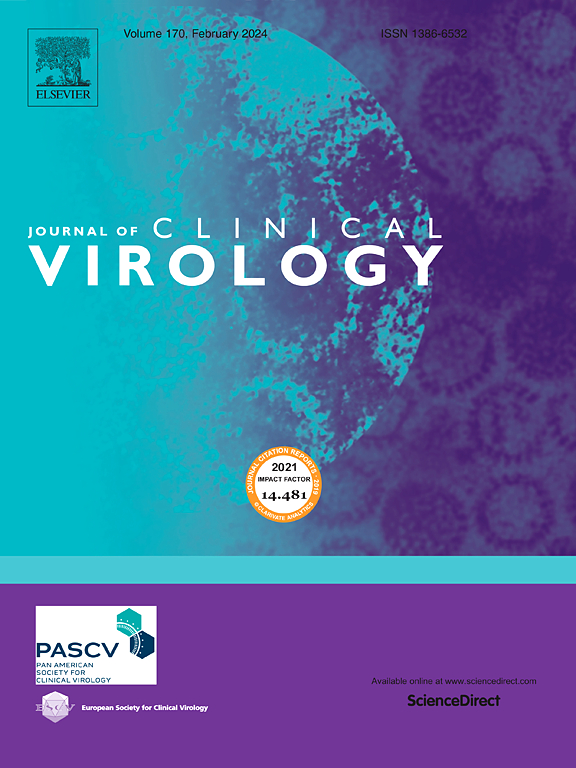美国密苏里州堪萨斯城儿童出现Parechovirus-A5中枢神经系统感染
IF 3.4
3区 医学
Q2 VIROLOGY
引用次数: 0
摘要
背景:在美国和全球范围内,小儿麻痹病毒- a5 (PeV-A5)血液和中枢神经系统(CNS)感染是罕见的。我们报告了2024年密苏里州堪萨斯城婴儿中出现的PeV-A5感染。方法作为堪萨斯城儿童慈善医院(CM-KC)护理标准的一部分,于2024年对婴儿脑脊液(CSF)和血液样本进行parechoovirus - a (PeV-A)检测。PeV-A检测包括两步逆转录聚合酶链反应,并使用Sanger测序进行基因分型。我们分析了2024株PeV-A病毒的氨基酸序列和系统发育,并描述了PeV-A感染婴儿的临床特征。结果248例患者的211份脑脊液和46份血液标本中,检出PeV-A感染者10例(4%),其中脑脊液8例,血液2例。9例PeV-A感染患者的病毒分型成功,其中8例为PeV-A5(6例脑脊液,2例血液),1例为PeV-A4(脑脊液)。CM-KC的PeV-A5病毒序列与其他已知的PeV-A5序列聚类,与2018年日本札幌市的PeV-A5病毒序列最相似(> 97%)。CM-KC的PeV-A5检测呈夏秋季季节性。8例PeV-A5感染患者在CM-KC与先前的PeV-A3和PeV-A4感染患者相比,均出现皮疹症状,易激惹性减轻,最高体温降低。结论2024年在美国密苏里州堪萨斯城的婴儿无菌部位(CSF、血液)检测到的PeV-A5是主要的PeV-A基因型,代表了一年内美国婴儿中PeV-A5全系统疾病的最高数量。本文章由计算机程序翻译,如有差异,请以英文原文为准。
Emergence of Parechovirus-A5 central nervous system infections in children from Kansas City, Missouri, USA
Background
Parechovirus-A5 (PeV-A5) blood and central nervous system (CNS) infections are rare in the United States of America (USA) and globally. We report an emergence of PeV-A5 infections among infants in Kansas City, Missouri, in 2024.
Methods
Cerebrospinal fluid (CSF) and blood samples from infants were tested for Parechovirus-A (PeV-A) in 2024 as a part of standard of care at Children's Mercy Kansas City (CM-KC). PeV-A testing included a two-step reverse transcriptase-polymerase chain reaction, and genotyping was conducted using Sanger sequencing. We analyzed the amino acid sequences and phylogeny of the 2024 PeV-A viruses and described the clinical characteristics of PeV-A infected infants.
Results
Among 211 CSF and 46 blood samples from 248 patients, 10 (4 %) PeV-A infected patients were detected (8 CSF, 2 blood). Genotyping was successful for viruses from 9 PeV-A infected patients, with 8 identified as PeV-A5 (6 CSF, 2 blood) and 1 as PeV-A4 (CSF). PeV-A5 viral sequences from CM-KC clustered with other known PeV-A5 sequences, being most similar (>97 %) to a PeV-A5 viral sequence from Sapporo City, Japan, in 2018. PeV-A5 detections from CM-KC occurred with a summer-fall seasonality. All 8 PeV-A5 infected patients had symptoms of rash with less irritability and lower maximum temperature when compared to previous PeV-A3 and PeV-A4 infected patients at CM-KC.
Conclusions
PeV-A5 emerged as the predominant PeV-A genotype detected from sterile sites (CSF, blood) in infants in Kansas City, Missouri in 2024, representing the highest number of PeV-A5 systemic illness in infants in the USA within a year.
求助全文
通过发布文献求助,成功后即可免费获取论文全文。
去求助
来源期刊

Journal of Clinical Virology
医学-病毒学
CiteScore
22.70
自引率
1.10%
发文量
149
审稿时长
24 days
期刊介绍:
The Journal of Clinical Virology, an esteemed international publication, serves as the official journal for both the Pan American Society for Clinical Virology and The European Society for Clinical Virology. Dedicated to advancing the understanding of human virology in clinical settings, the Journal of Clinical Virology focuses on disseminating research papers and reviews pertaining to the clinical aspects of virology. Its scope encompasses articles discussing diagnostic methodologies and virus-induced clinical conditions, with an emphasis on practicality and relevance to clinical practice.
The journal publishes on topics that include:
• new diagnostic technologies
• nucleic acid amplification and serologic testing
• targeted and metagenomic next-generation sequencing
• emerging pandemic viral threats
• respiratory viruses
• transplant viruses
• chronic viral infections
• cancer-associated viruses
• gastrointestinal viruses
• central nervous system viruses
• one health (excludes animal health)
 求助内容:
求助内容: 应助结果提醒方式:
应助结果提醒方式:


